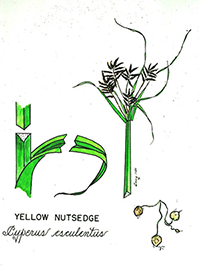Sedges

Sedges are grass-like plants and considered one of the world’s most pernicious weeds. They invade gardens and turf across the planet. Even Antarctica is host to an invasive sedge species! With an introduction like that, it’s no surprise that sedges are a problem in Florida.
A few species, including yellow nutsedge (Cyperus escuelentus), are native to North America. Others, like purple nutsedge (C. rotundus), are of unknown origin; they have invaded so many areas that their home habitat is a mystery.
A common but inaccurate name for many sedge species is “nut-grass.” In Florida the most common species are yellow and purple nutsedge. Texas, annual, and water sedges, as well as perennial kyllinga are also a problem.
Sedges are of little economic value to humans. In the landscape they are very competitive for water, nutrients and space. It’s because of this competition with our landscape plants that we consider them weeds.
Identifying Sedge
Sedges can be annuals but most species found in Florida are perennials. A wide range of conditions and soil types will support these weeds. They reproduce primarily by “runners,” rhizomes beneath the surface of the soil. Sedges are easily identified by their tall, flower-bearing stems. Despite these flowers, sedges do not usually reproduce by seeds. In many of the common sedge species, seed production and viability are low; seedlings are rare.

In wetland habitats it is easy to mistake some rushes for sedges. Sedges have triangular-shaped, solid stems. Rush stems, on the other hand, are round and solid. To help remember the difference, botany students recite this rhyme:
“Sedges have edges, and rushes are round,
But grasses have nodes from their tips to the ground.”
The “edge” refers to the edges of the triangular stems most sedges share. The leaves are often arranged in groups of three, too.
Below ground most species have rhizomes (runners). Some sedges have tubers as well. These underground structures are the secret to sedge’s rapid spread. They are also what makes this weed so difficult to remove completely.
Controlling Sedge
In Florida, sedges are a persistent problem. The first step in controlling them is to avoid providing an ideal habitat. These weeds thrive in soils where the turf is struggling to form a healthy root system. Areas that remain wet for extended periods of time are vulnerable to sedge and other turf grass problems. High foot traffic and soil compaction are other risk factors.
Excessive irrigation is a common error in Florida landscape management. Before you begin attacking individual sedges, correct the cause of continuously wet sites. Learn how to have a better lawn by using less water. Improved surface and subsurface drainage may also be necessary. Remember, the sooner you address these moisture problems, the sooner you stop watering the weeds.
Once the environment has been corrected you can start removing existing sedge. Begin by inspecting your landscape to gauge the extent of the problem.

Credit: Steve Dewey, Utah State University, Bugwood.org
If your landscape has few areas infested with sedges, then hand-pulling can be effective. Be sure to remove all underground structures like runners and tubers. Check back after a few days and pull any newly-emerged sedge. Continue checking and weeding as necessary. This method is certainly the most environmentally friendly option.
In landscapes overrun by sedge, pulling by hand may not be an effective solution. Unfortunately, landscape cloth is also ineffective at controlling sedge. Even mulch at the recommended depth cannot keep these weeds at bay.
Herbicides and Cautions
Yellow and purple nutsedge are the most common sedge weed species in turf grass. Both these, and the less common species, can be controlled with herbicides. Because regrowth from the roots and tubers is common, repeated applications are often necessary. In fact, chemical control efforts may go on for several years before the sedge is eliminated.

Please remember that when it comes to pesticides, the label is the law. Herbicides are safe and effective only if you read and follow all of the instructions on the product’s label. It is dangerous, wasteful, and illegal to do otherwise.
Pay special attention to the restricted-entry interval (REI) information. Home lawns are frequently visited by children and pets. For their safety, make sure they do not enter the treated area during the REI.
UF/IFAS provides up-to-date herbicide information though the Electronic Data Information Source (EDIS). For sedge, consult the Weed Management Guide for Florida Lawns and Sedge Biology and Management in Turf. You can purchase sedge herbicides alone or in products with multiple active ingredients. Many of these are sold for turf grass or other landscape areas. Some herbicides are labeled for use in planting beds. The labeling recommendation will depend on what other herbicides are included. Unless it is labeled for edibles, do not use an herbicide near an edible crop.
Also on Gardening Solutions
- A Better Lawn on Less Water
- Integrated Pest Management (IPM)
- More Weeds and Invasive Plants
- Pesticide Labels

UF/IFAS Publications
- Biology and Management of Yellow (Cyperus escuelentus) and Purple Nutsedge (C. rotundus) in Ornamental Crop Production and Landscapes
- Identification of Sedge and Sedge-Like Weeds in Florida Citrus
- Improving Weed Control in Landscape Planting Beds
- Nonchemical Weed Control for Home Landscapes and Gardens
- Sedge Biology and Management in Turf
- Watering Your Florida Lawn
- Weed Management Guide for Florida Lawns
